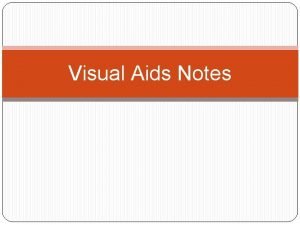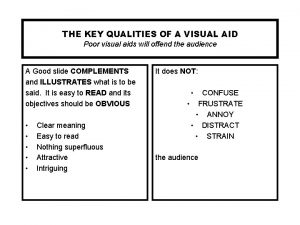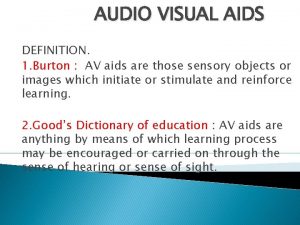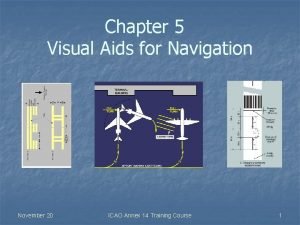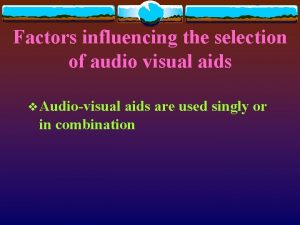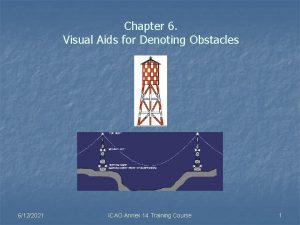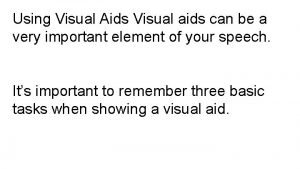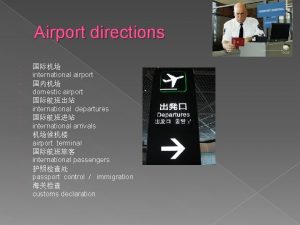Training of Airport Visual Aids Maintenance Personnel Airport














- Slides: 14

Training of Airport Visual Aids Maintenance Personnel “Airport Operator” - Are you Meeting the Requirements? IESALC Denver 2015 Presented by Seward Ford ACE Visual Aids Services Inc.



We Need To Create a New Safety Culture Safety is everyone’s responsibility and our own responsibility. We cannot delegate our safety responsibilities to others. It is our responsibility to set the safety example for others. Safe work practices is a learned attitude and skill we should be passing on to our fellow workers and our family. Become familiar and knowledgeable with National Fire Protection Association (NFPA) 70 E, Standard for Electrical Safety in the Workplace.

Who is Qualified to Perform Maintenance? Qualified Person. One who has skills and knowledge related to the construction and operation of the electrical equipment and installations and has received safety training to recognize and avoid the hazards involved. NFPA 70 E-2012 A person may be considered qualified for certain tasks and not qualified for others.

Some Qualification Particulars ü The qualified person must possess the requisite technical skills and be trained to recognize and avoid electrical hazards. ü The qualified person must also be trained in the proper procedures for operations in an aircraft operation area (AOA).

You must be able to ---ü ü Distinguish exposed live parts from other parts. Determine nominal voltage of exposed parts. Determine the approach distances in NFPA 70 E; Table 130. 2(C). Possess the decision-making skills necessary to determine the degree and extent of hazard, PPE required and planning to safely perform the job.

You must also be able to plan your task to ensure an “electrically safe” work condition by: ü Assessing the hazards associated with the work. Ø Shock hazard and flash hazard analysis ü Planning safe work procedures and any special precautions. ü Establishing energy source controls. ü Determining Personal Protection Equipment (PPE) requirements.

You must be able to implement your plan by…… 1. Determine all sources of energy to the equipment. 2. Turn off the equipment using proper controls; open the disconnecting means for each electrical source. 3. When possible, visually verify all blades of the disconnecting device are fully open and/or draw-out type circuit breakers are withdrawn to the fully open position. 4. Verify all other energy sources have been identified and turned off, removed, blocked or secured as required to safely and properly control the specific energy source.

You must be able to implement your plan by…. . 5. Applying lockout/tagout devices per documented and established policy. 6. Using an adequately rated volt meter to test phase-to-phase and phase-to-ground for voltage (clamp on ammeter). Before and after the test, verify the properation of the test equipment. 7. Where the possibility of induced voltages or stored electrical energy exists, ground the phase conductors or circuit parts. If components could become reenergized use grounds that can withstand fault currents.

So what is an electrically unsafe work condition? An electrically unsafe work condition is defined as “working on or near live parts of 50 volts or more. ” The word, “near” is defined as “within the limited approach boundary provided by NFPA 70 E, Table 130. 4(C) and Table 130. 4(C)(b). ” To perform work on or near live parts of 50 volts or more, the following steps must be accomplished: 1. Justification – Demonstrate that de-energizing introduces additional or increased hazards or is not feasible due to equipment design or operational limitations. (see NFPA 70 E, Section 130. 2) 2. Complete an energized work permit that authorizes work on energized equipment.

What does AC 150/5340 -26 C now give us? 1. It gives us the procedures and processes that we must implement to provide a comprehensive preventative maintenance program. 2. It defines for us what specific training must be provided for the airfield maintenance worker so he or she can be considered competent for the action they are going to undertake.

What is the Message I leave with you today? 1. To the maintenance worker – Stay Safe! Make sure you get properly trained so you are qualified for the particular work you do. Do not work on energized circuits 2. To the airport - Keep your airport safe for worker and passenger and reduce your liability exposure by providing the required training.

Training of Airport Visual Aids Maintenance Personnel “Airport Operator” - Are you Meeting the Requirements? IESALC Denver 2015 Presented by Seward Ford ACE Visual Aids Services Inc.
 Airport visual aids
Airport visual aids Toilet training visual aids
Toilet training visual aids Payload range
Payload range Visual aid definition
Visual aid definition Disadvantages of flip chart
Disadvantages of flip chart Bad visual aids
Bad visual aids Principles of audio visual aids
Principles of audio visual aids Definition of av aids
Definition of av aids Contoh audio visual aids
Contoh audio visual aids Apron safety lines
Apron safety lines Three dimensional visual aids
Three dimensional visual aids Selection of audio visual aids
Selection of audio visual aids Visual aids for denoting obstacles
Visual aids for denoting obstacles Multimedia visual aids
Multimedia visual aids Types of training aids
Types of training aids



